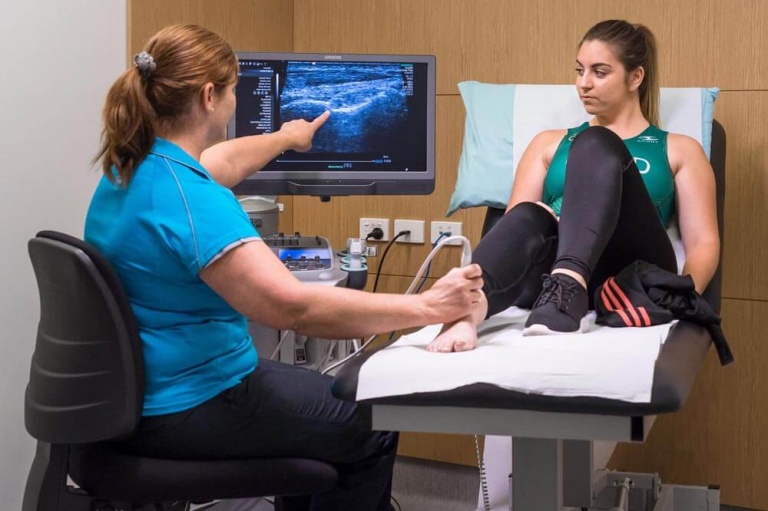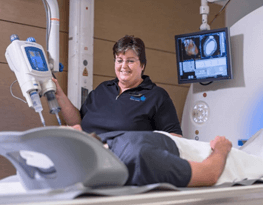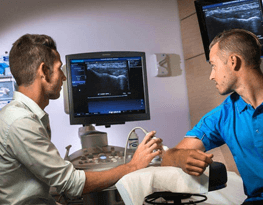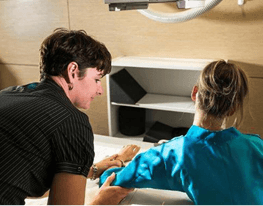What is an FNA or Biopsy?

A fine needle aspiration (FNA) is a procedure to removes some fluid or cells from a lesion or cyst with a fine needle. The sample of fluid or cells is sent to a pathology laboratory for examination. An FNA is performed to help determine the nature or diagnosis of the lesion and to plan treatment if necessary. It is commonly used to investigate breast, lymph nodes and liver.
Core Biopsy may sometimes be used instead of FNA. The needle biopsy procedure involves making a small incision in the skin and inserting a larger needle to take the tissue samples. Unlike FNAs, the larger needle size allows the cells to be removed with their relationship to each other intact which may help in diagnosis. Needle biopsies are done under local anaesthetic.
Both of these procedures are performed under ultrasound guidance by a radiologist.
FNA or Biopsy
What happens during an FNA or Needle Biopsy?
A. Before your scan
What to bring
- Your request form
- Any relevant previous imaging
- Your Medicare card and any concession cards
Preparation – the day of your procedure
When you arrive for your procedure you will be asked to remove jewellery and change into an examination gown.
B. During your FNA or Biopsy
Procedure
You will be made comfortable on the examination table. The skin at the injection site is cleansed and prepared and local anaesthetic may then injected.
For an FNA, a thin needle (similar to a needle used for taking a blood sample), is placed through the skin into the area being investigated to sample the area of interest. Ultrasound guidance is used to ensure precise placement. The needle is gently moved back and forth at the investigation point to enable cells to be collected.
During a core biopsy, a small cut is made in the skin and the biopsy needle is gently inserted into the area being investigated, under ultrasound guidance. Several samples will be taken and you will hear a clicking noise and may feel some pressure where the samples are being taken. After the samples have been taken, pressure will be applied to help minimisebruising or bleeding, then a dressing is applied to the injection site.
Both the FNA and Core Biopsy procedures takes about one hour.
Risks and Side Effects
Complications are uncommon during these procedures, however, you need to be informed of the possible side effects and associated risks.
- Pain, bruising, temporary numbness, tingling or discomfort at the injection site
- Infection is very rare but may involve redness or swelling and increasing pain after 48 hours. Increasing pain should be promptly reported to us and your referring doctor
- Any medical procedure potentially can be associated with unpredictable risks.
Do not hesitate to contact our office on 6382 3888 if you have any questions or concerns.
Who will perform my FNA or Biopsy?
Your biopsy will be performed by a Radiologist (medical specialist).
FNA or Biopsy
What happens after an Ultrasound Guided FNA or Needle Biopsy?
How do I get my results?
Your samples will be sent to a pathology laboratory for investigation and the results sent to your doctor. Please make a follow up appointment with your doctor or specialist to discuss your results.
Post-procedural Information
Some swelling or discomfort is common in the first few days after your injection. You may use an icepack on the injection site for 20 minutes or paracetemol to avoid discomfort.
You should refrain from exercise for 24 hours following your biopsy, but should be able to return to normal daily activities. Your dressing may be worn in the shower and removed after two to three days.
If the infection site becomes red, swollen or tender in the days after your biopsy please consult your doctor or contact us on 6382 3888.
FNA or Biopsy
Download an Information and Consent Form
Medical Imaging Practice Perth
Types of Imaging
At Envision, we offer the most sought-after types of imaging for diagnostics and treatments. Our Wembley headquarters is the largest single-site radiology practice in Perth







